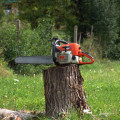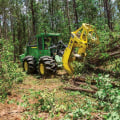In the world of forestry, landscaping, and land management, few machines are as indispensable and versatile as the chipper. Whether it's transforming fallen branches into mulch, reducing logging debris into manageable chips, or clearing brush for fire prevention and trail maintenance, a chipper is a key player in maximizing efficiency while minimizing waste. This essential equipment comes in various sizes and configurations, from small tow-behind units ideal for arborists and homeowners to massive industrial machines used in commercial forestry operations. At its core, a chipper is designed to break down large volumes of wood material into smaller, uniform chips through a high-speed cutting mechanism, either using sharp blades (disk chippers) or a rotating drum (drum chippers). This not only makes disposal and transportation easier but also allows the wood chips to be repurposed for landscaping, biomass fuel, erosion control, and even playground surfacing. For professionals in the forestry and tree care industries, the ability to chip on-site significantly reduces hauling costs and site cleanup time, while promoting environmental stewardship by recycling organic waste into usable products. Safety and efficiency go hand in hand with modern chippers, which now include features like hydraulic feed systems, emergency shut-offs, and sound-reducing enclosures to protect both operators and surrounding communities from accidents and excessive noise.
Boosting Productivity in Forestry and Land Clearing
One of the chipper’s greatest strengths is its role in increasing productivity. In logging operations, felling trees is only part of the job—processing limbs, branches, and offcuts can take up a large portion of labor time if handled manually or transported off-site. With a chipper on hand, workers can immediately reduce material volume, allowing for faster progress and cleaner work zones. In land clearing, whether for agriculture, road construction, or firebreaks, the chipper accelerates brush removal and eliminates the need for costly and environmentally harmful burn piles. Many modern forestry teams integrate chippers into a larger fleet of equipment, combining them with skidders, grinders, and stumpers to create a seamless workflow from standing tree to cleared, usable land. This adaptability makes chippers invaluable across diverse projects, from dense forest management to urban lot clearing. The chips produced can be left on-site as ground cover to prevent erosion or collected and sold, adding a potential revenue stream to an otherwise waste-heavy task. Even municipalities and utility companies use chippers to manage roadside vegetation and maintain clear utility corridors, reducing the risk of outages and wildfires.
Applications Beyond the Forest
Though chippers are rooted in forestry, their versatility extends well beyond timberland. Landscaping companies use them year-round to manage tree pruning, storm debris, and yard waste, helping clients maintain neat, sustainable properties. Gardeners and farmers benefit from converting hedge trimmings and orchard prunings into mulch that retains soil moisture and suppresses weeds. Even residential homeowners with large properties can benefit from having access to a smaller chipper, especially after seasonal cleanups or severe weather events. In more creative applications, artists and craftspeople sometimes use wood chips for composting, natural dyes, or decorative materials. Additionally, in urban development or storm recovery scenarios, mobile chipping services provide rapid, on-site waste reduction without needing to haul massive piles of organic debris through city streets—minimizing traffic disruption and environmental impact.
Maintenance, Safety, and Choosing the Right Equipment
With all the benefits chippers offer, choosing the right machine and maintaining it properly are crucial for long-term success. Different projects call for different models—smaller jobs may only require a gas-powered 6-inch chipper, while commercial operations demand heavy-duty 12-inch or larger diesel-powered units. Blade maintenance is one of the most critical aspects; dull blades reduce efficiency, increase strain on the engine, and pose safety risks due to erratic feeding behavior. Regular inspections for belt tension, hydraulic systems, and feed rollers ensure optimal performance and prevent costly breakdowns. Operator training is equally important, as improper use can lead to serious injury. Professionals must be trained to maintain a safe feed distance, avoid wearing loose clothing, and remain vigilant while the machine is in use. Storage and transport also matter—securing the chipper properly during transit and keeping it sheltered from weather can prolong its lifespan and reliability. Interestingly, even companies not directly related to forestry, such as a roofing company, may use chippers when clearing trees or overhanging branches that interfere with roofing projects—demonstrating just how wide-reaching the chipper’s utility can be.
Conclusion: A Silent Powerhouse of the Industry
The chipper may not be the flashiest machine in the forestry fleet, but its contribution is undeniable. It streamlines operations, reduces waste, enhances safety, and opens up valuable reuse opportunities for what was once discarded material. As sustainability becomes more central to land management practices, the chipper’s role in converting wood debris into usable, eco-friendly products makes it an essential piece of equipment across industries. Whether in dense woodlands, suburban neighborhoods, or bustling city cleanup efforts, the chipper quietly powers productivity and promotes environmental responsibility—living up to its reputation as one of the most versatile and valuable tools in modern forestry and beyond.







